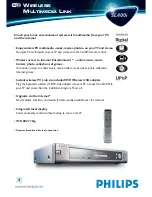
Installation
150-712-200-02
10
July 26, 2000
HRE-712 List 1 and List 2
3
Position the mounting bracket against the wall and mark the location of the four outside mounting holes.
Remove the mounting bracket.
4
Drill four
1
/
4
-inch (0.635 cm) diameter holes 2
1
/
2
inches (6.35 cm) deep at the locations marked in
5
Start an anchor bolt in each of the two top, bolt-mounting slots and screw the bolt into the wall approximately
2
/
3
inch.
6
Insert and tighten the anchor bolts in the two bottom mounting holes located on the outside of the mounting
bracket.
7
Secure the enclosure bracket to the wall by tightening all anchor bolts.
8
Reattach the enclosure base mounting brackets to the mounting bracket with the four side plate bolts and
torque the mounting bracket bolts 30 to 40 inch-pounds (3.4 to 4.5 Newton-meters).
9
If the cable stub connects to an underground cable, dress the cable down the wall to the splice case. If the
cable stub connects to an aerial cable, form a drip loop in the cable and dress it up the wall to the splice case.
Rack Mounting the HRE-712 List 1
This procedure describes how to mount the enclosure in a rack.
Have the following equipment ready before you begin this procedure:
•
Four
3
/
8
-inch thru-bolts for rack mounting.
•
Four
3
/
8
-inch nonmetallic washers.
•
One wrench.
To rack mount the enclosure, follow these steps:
1
Select a location on the cable rack.
2
Position the enclosure so that the holes in the mounting bracket align with the mounting holes in the cable
rack.
3
Slide the thru-bolts with nonmetallic washers through the outside slots and holes of the mounting bracket.
Begin tightening the bolts into the mounting holes.
4
Secure the enclosure to the rack by tightening the thru-bolts.
5
Dress out the stub and attach it to the main feeder cables as described in
“Splicing Procedure” on page 29
6
Activate the desiccant bag shipped with the HRE-712 prior to closing the lid by removing the bags from their
plastic containers and placing them inside the enclosure.
Nonmetallic washers are required to avoid a ground loop that may result if both the rack and the
enclosure are grounded. Do not use the rack ground for the enclosure ground since its integrity
is not 100 percent reliable.
















































